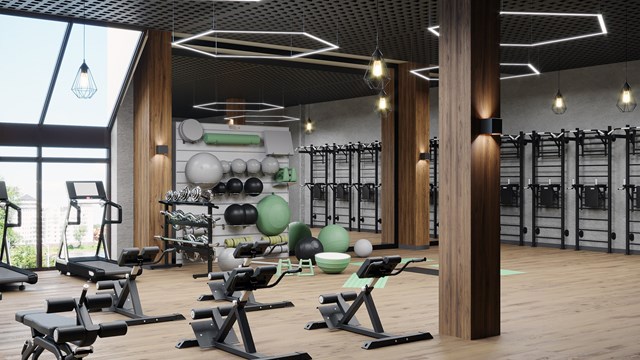While current technology allows one to access almost infinite information in real time, history allows one to look back. And for many New Yorkers, the city’s rich architectural tradition is inscribed in the countless prewar buildings that populate the five boroughs—many of which have achieved official landmark status. But what is the protocol when these buildings want to update amenities or appearance to remain competitive, while staying true to their historic roots?
“A lot of prewar buildings and buildings built in the 1960s and 1970s didn’t have amenities like gyms or fitness centers, they only had laundry rooms and storage rooms all for which were located in the basement,” says Ethelind Coblin, principal at the New York City-based Ethelind Coblin Architect, P.C., which specializes in residential architecture and interior design including lobbies, hallways, fitness centers and apartments.
“What happened is that the market got so hot, Park Avenue and Fifth Avenue and everyone else realized they had to upgrade their buildings because buyers were looking at newer buildings with these types of amenities,” says Coblin.
Coblin goes on to say that she is inundated with project requests for co-ops and condos. Since 1989, she worked on roughly 10 prewar co-op or condo buildings that required amenity upgrades. In the last year or so, she has seen over a half-dozen such project requests cross her desk.
And the trend isn’t limited to prewar properties. “We are also seeing buildings like the Bromley on West 83rd Street, which was built in the 1980s, upgrading the amenities they already have,” she says. “And what we are seeing from board members of all types of buildings is that they want to add amenities like playrooms and fitness centers to remain competitive. I bet other firms are getting a lot of calls, too.”
Landmark Issues
For buildings owners and boards approaching the concept of updating amenities, there is a fine line when it comes to construction, especially for landmark buildings. But there are also some misnomers, explains Gregg Annunziata, owner of the New York-based Landmark Properties and project manager at Metropolitan Builders of NY.
“If you are working on a landmark building in New York City and doing exterior work, you have to get approval from the Landmarks Preservation Commission (LPC),” says Annunziata. “For interior work, I’m not aware of any landmark requirements—just the normal required work permits.”
Annunziata explains that there are considerable efforts made by boards, building owners and contractors to ensure historic interior elements such as ornate moldings, solid-wood mantels and balustrades, grand marble staircases, French doors, leaded glass and the like are matched.
“They of course want you to try and match everything to the original materials and design to keep the character of the building—from stone to woodwork,” he says.
The number of landmark co-ops in all five boroughs is an impressive list (which you can see at www.nybits.com. Another site, www.cityrealty.com, provides information on hundreds of prewar co-op and condo buildings.) Annunziata says the booming residential real estate market juxtaposed against this niche market of buildings that require amenity upgrades keeps his phone ringing.
“With the majority of the older buildings, the work is all done in the basement,” he says. “We are building out for power, converting spaces, sheeting rocking new spaces, flooring and painting and the list goes on. Right now we are working for the owner of a building on 23rd and First Avenue who is converting a 140-unit rental property into condos. Laundry rooms and storage areas are getting smaller and gyms and common rooms are getting bigger—that’s the trend.”
For Coblin, the first step with a new client is to develop a master plan of the proposed amenities upgrade. In general, she says that from a usable space perspective, basements in older buildings were poorly designed. As a result, a master plan can allow a board to conceptualize the possibilities of what amenities can be delivered.
“There might be a laundry room that is 30 feet by 40 feet when [the building] only needs three washers, three dryers and a flop sink,” says Coblin. “A thorough master plan allows a board and management company to see how the space can be reallocated.”
Attorney Stuart Saft leads Holland & Knight’s New York Real Estate Practice Group and is the co-chair of the firm’s Condominium Development & Conversion Team. Saft has acted on behalf of the sponsor in the rebuilding and sale of condo units in the five landmarked buildings that make up Manhattan House on the Upper East Side. And he literally takes his work home with him.
“I live in and have been the president of the board of a prewar building, which is in a landmarked district. We have had several projects over the years bringing this 1924 Delano & Aldrich designed Georgian style building up to date,” notes Saft. “Two decades ago, we did an exterior renovation project and, in removing decades of grime found an amusing third story frieze of tortoise and hare figures surrounding the building, which we had carefully and professionally restored.”
In 2007, Saft’s board turned its focus inward, spending $1.5 million dollars to restore the lobby, which had been “modernized” in the 1950s. The goal was to restore the lobby to the original design, says Saft. To achieve this objective, architectural historians were hired to ensure that all the design elements were consistent, while adding current amenities including central air conditioning (without damaging the original design).
“The lobby was not landmarked, so we could have done whatever we wanted, but the board felt strongly that we wanted to recapture the grandeur of the lobby and had three shareholders meeting to get support for our vision,” says Saft. “When we started, there were a great many complaints about the cost from the longer time residents but, once the lobby was completed, everyone agreed that it was worth the cost.”
Coblin says that while bureaucratic red tape may be limited on most interior projects at landmark and prewar buildings, there are still protocols that need to be followed. Most projects, she says, will require an amended certificate of occupancy (C of O).
“For example, the use of a fitness center will not be listed on the original C of O, and is rather listed as a storage, locker room or boiler room,” says Coblin. “The building should be straightforward and amend the C of O all at one time.” She adds that this process can take four to six months, depending on how many violations may need to be addressed beforehand.
“If a building was to move forward with a fitness center, for example, and there was a doctor’s office on the same floor, it would have to be closed out,” says Coblin. “So there’s a little administrative tape to take care of, but generally these updates are good for the building.”
Evolving Amenities
For many co-ops and condos, undertaking a capital improvement project like adding a fitness center or conference room is simply not in the budget. And while it makes sense to undertake the total scope of the proposed project at the same time, in some cases boards have a fiduciary responsibility to take a longer view.
“Five years ago, the board decided that the building needed a fitness center, which was not part of the original design, but we were able to capture space on the first floor of the building and created a modern gym in an unobtrusive area,” says Saft. “Over the years, we have also replaced the original, manned elevators with automatic elevators and moved the employees who operated the elevators into a concierge desk in the lobby, which was more useful for the shareholders.”
Another aspect of budgetary concerns is the ability to preserve the character of the building. This may require seeking the right hardwood for flooring or decorative crown molding. While Coblin says boards can turn to historians architectural consultants, her firm has presented designs to the LPD numerous times—and sometimes is surprised by the response. In one case, her client owned a landmarked building, and her design was more modern than the building itself. LPD accepted the design.
“They aren’t always looking to be matchy-matchy. Sometimes they are looking for an amenable move that is elegant for an older building,” she says. “So it’s not just that the new feature looks old, but that it is appropriate. In some of the lobbies we have done, for example, we have maintained a very traditional approach, but there are times when it is wise to be sleek and minimal.”
As with any construction project, there will be disruption to shareholders and residents day-to-day life. But that is part of the process of adding value to the property and remaining competitive in New York’s residential real estate market. With a majority vote and sufficient reserve funds, co-ops and condos boards can partner with professionals to ensure the job is done right.
“None of these jobs have been simple, they all came with challenges and we used specially trained architects and designers to achieve our goal of turning a dated mid-20th century look back to the originally designed early 20th century elegance of Delano & Aldrich, while modernizing the building and increasing the amenities for our shareholders,” says Saft.
When looking at the calendar, Coblin says that in order to “do justice” to the project, boards should figure on a one year time frame—from project discovery to completion. What transpires between these milestones, include countless meetings, which requires board oversight and due diligence.
Know What You Want
Coblin’s advice for board members is to really “know and understand” their shareholders and residents wants and needs. For example, just because space is allocated for a fitness center, it shouldn’t be massive just because there is new space allocated.
“Whether you have 60 shareholders or 180 shareholders, the space has to be scaled appropriately,” says Coblin. “Many residents are turned off when they see a great big fitness center that always looks empty. It’s a waste of resources. That why a master plan is so key to a successful project.”
Today’s buyers are looking for high-end amenities like wine cellars, outdoor community space, children’s playrooms and theater rooms, while outdated business conference rooms are being transformed into luxury multi-purpose lounges. And speed ovens, The New York Times reports, are being incorporated into new developments instead of traditional conventional ovens or microwaves.
Brad King is a freelance writer and a frequent contributor to The Cooperator.







Leave a Comment